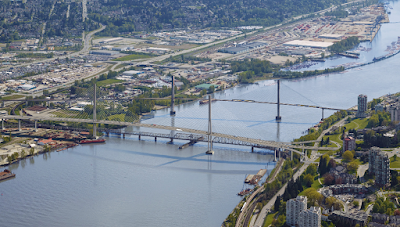 |
| Artist drawing of proposed replacement Pattullo Bridge. Select image to enlarge. |
In October, I posted about some of the design options that were being considered for the replacement Pattullo Bridge. TransLink was seeking public feedback on the design at that time with a focus on cycling and walking connectivity between Surrey and New Westminster.
TransLink has recently released the results of the public consultation in which 2,233 people participated. 60% of participants, a clear majority, supported both improving cycling and walking infrastructure in Surrey and New Westminster, connecting to and along the bridge.
Around 15% of the people who provided written feedback on walking/cycling connectivity noted that they opposed these improvements because there aren’t many people walking or cycling in the area today.
Giving the state of the Pattullo Bridge and surrounding road network, it is no surprise that people only drive. Generally, when improvements are made to make cycling and walking safer and more inviting, more people will walk or cycle.
One of the interesting questions asked about New Westminster walking access was whether people would support grade-level crossings with flashing crosswalk lights, or an overpass at the Royal Avenue On-Ramp. There was clear support for the overpass, and little support for the at-grade crosswalk.
It is interesting to see that about a third of the people who provided written comments on overpasses vs. at-grade crossings, didn’t support at-grade crossings because they “interrupt traffic flow.” There are traffic lights throughout New Westminster and Surrey that interrupt traffic flow, so whether you queue near the bridge or the next light, it likely doesn’t really matter as far as increasing travel time goes.
One thing I know about walking/cycling overpasses is that people will only use them if there are no other options. If there is even the slightest chance of crossing at-grade, people will do that. I hope the design of walking and cycling access for the Pattullo Bridge takes this into account, and reduces the barriers to walking and cycling safely as much as possible.
People who participated in the public consultation process were also giving the opportunity to provide additional feedback. Of all the additional feedback received, only around 30% of people commented about their opposition to tolling.
For more information about the public feedback received, check out the full report.

No comments:
Post a Comment